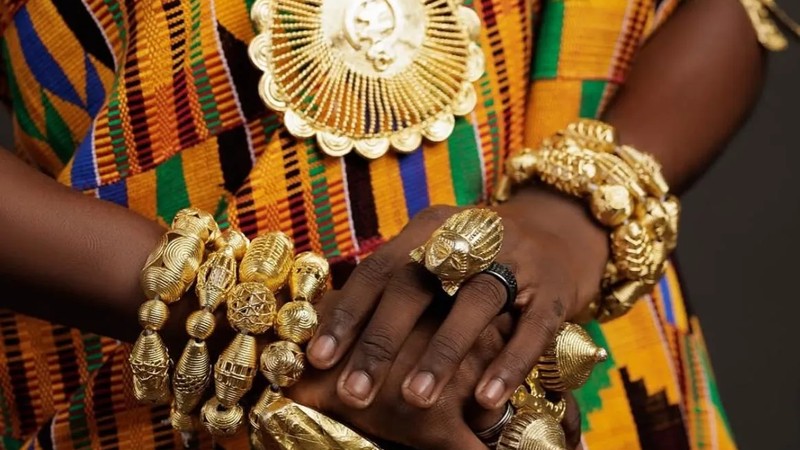There are moments in fashion that shift the global conversation when fabric becomes more than fashion, and a weave becomes a world symbol.
This month, Ghana gave the world one of those moments.
Kente, the vibrant, handwoven cloth that has draped kings, bridged generations, and coloured runways from Paris to Johannesburg, has officially been granted Geographical Indication (GI) status.
It’s a move that doesn’t just protect a textile; it protects a legacy.
This recognition, granted through the World Intellectual Property Organisation (WIPO), means only Kente woven in certified Ghanaian communities, such as Bonwire, Adanwomase, Agotime Kpetoe, Agbozume, and Tafi Atome, can rightfully bear the name “Kente”.
Call it the Ghana Kente. Call it the reclaiming of identity. Either way, Africa just set the bar for how fashion honours its roots.
A historic stitch in time
This wasn’t just another policy announcement; it was a fashion revolution cloaked in cultural pride.
For years, Kente prints have dominated global runways and digital stores, yet much of what we’ve seen has been imitation. The real story, the rhythmic loomwork, the symbolism, the generational artistry, was being lost in translation.
Now, that changes. With GI protection, every genuine Kente will carry a traceable code verifying where it was woven and by whom, giving Ghanaian artisans rightful ownership and access to the global fashion economy.
According to “The Business and Financial Times” online, Grace Ama Issahaque, Ghana’s Registrar-General, explained during the launch in Accra, this milestone “marks a turning point for thousands of weavers whose artistry has defined our identity for centuries.”
To understand its weight, think of Champagne from France or Parmesan from Italy, luxury products tied to place and people. Kente now joins that league.
View this post on Instagram
It’s official: the world can no longer mass-produce Ghana’s heritage.
Each Kente pattern carries meaning, wisdom, unity, strength and renewal. Every thread is a conversation between ancestry and aspiration.
If you look closer, this victory resonates beyond Ghana’s borders. Across Africa, fashion is stitched with stories, and South Africa knows this well.

Our own umbhaco, the Xhosa traditional attire, carries deep cultural meaning, often worn during weddings and initiation ceremonies as a symbol of transition and pride.
Like Kente, umbhaco has become a muse for contemporary designers but remains largely unprotected under intellectual property law. While creators can register specific designs under the Designs Act (No. 195 of 1993), the traditional patterns themselves often belong to the collective, which makes enforcement tricky.
Then there’s the beadwork in Zulu and Xhosa cultures, where colours and patterns are more than aesthetic choices; they are languages of love, status, and belonging. Yet mass-produced imitations often strip those meanings for profit.
And of course, one of the most powerful examples is Laduma Ngxokolo, founder of MAXHOSA AFRICA. His luxury knitwear brand has taken traditional Xhosa beadwork patterns and translated them into global fashion, proudly displaying how modern design and heritage can coexist.
His work has graced international runways while staying rooted in homegrown identity, a testament to what protection and storytelling can achieve.
As Loretta Asiedu, WIPO’s Director for Africa, put it, this moment is where “heritage meets opportunity.”

Behind that poetic line lies something deeply practical: economic justice. Local weavers can now license their designs, export under their own labels, and finally earn fairly from the global demand they have fuelled for decades.
For communities like Bonwire and Agotime, this isn’t just protection, it’s pride, it’s tourism, it’s employment. The GI status transforms these weaving villages into cultural powerhouses, destinations for fashion enthusiasts and storytellers seeking authenticity.
The GI milestone also comes on the heels of another major recognition: in December 2024, UNESCO officially listed traditional Kente weaving as part of the Intangible Cultural Heritage of Humanity.
Together, these two recognitions, Unesco and WIPO, create a powerful global blueprint for how African craftsmanship can move from inspiration to institution.
From South Africa’s Umbhaco to Nigeria’s Aso Oke, many of our traditional textiles remain unprotected, celebrated globally but owned by no one locally.
While designers can safeguard modern adaptations under the Designs Act (No. 195 of 1993), traditional weaves often fall through the cracks, classified as “shared heritage” and left open to exploitation. Ghana’s breakthrough shows it doesn’t have to stay that way.
Halala to Ghana!
